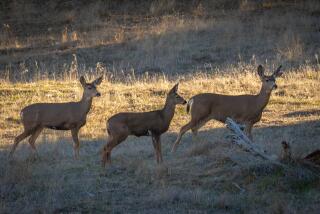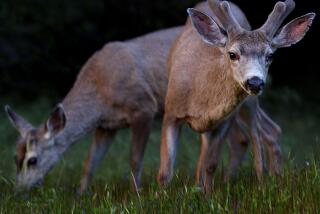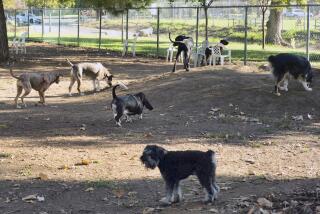‘Mad Cow’ Disease in Deer Not Ruled Out as Threat
BETHESDA, Md. — Scientific evidence so far does not show that a fatal illness resembling “mad cow” disease that afflicts deer and elk in the Western United States can spread to humans, an advisory panel said Friday.
Still, the possibility that the illness, called chronic wasting disease, could be harmful to people cannot be ruled out, and researchers and the government should continue monitoring and studying it, members of an advisory panel for the Food and Drug Administration said. Chronic wasting disease, sometimes called mad deer disease, has been found in both wild and confined animals in six U.S. states. Experts are concerned because it is in the same family of illnesses as mad cow disease, or bovine spongiform encephalopathy, which is spreading throughout Europe.
People who eat beef tainted with BSE can develop a deadly human version, scientists believe. More than 80 people in Britain have died of the human form, called new variant Creutzfeldt-Jakob disease.
A panel of scientific advisors to the FDA concluded that studies to date did not show that the same thing can happen with chronic wasting disease, but that does not mean it can be ruled out.
Elk and deer meat is consumed as food in the United States, although on a much smaller scale than beef. Antlers from the animals are also ground and used in some dietary supplements.
“There is no evidence for transmission, but that does not mean transmission could not occur,” said panel member David Bolton of the New York State Institute for Basic Research.
Chronic wasting disease was first identified in the United States in the 1960s. The illness causes the same spongelike holes in the brain as mad cow disease does in cattle. Initial symptoms in deer and elk include weight loss and abnormal behavior.
Cases among wild animals have been confined to northeastern Colorado, southeastern Wyoming and a small part of Nebraska.
Chronic wasting disease also has been found on 13 elk farms in Colorado, Montana, South Dakota, Oklahoma, Nebraska and in Saskatchewan in Canada. Industry groups said they voluntarily destroyed herds when one animal was found to be infected with the disease.
Three Americans under age 30 who had Creutzfeldt-Jakob disease ate deer and elk meat when they were young. The disease has a long incubation period, and young people rarely die of the disease, which can start spontaneously.
The cases suggest a possible relationship with chronic wasting disease, but investigations found “no strong evidence of a causal link” with the patients’ illnesses, Dr. Ermias Belay of the national Centers for Disease Control and Prevention in Atlanta told the panel.
The panel’s review was part of the FDA’s efforts to keep mad cow disease out of the U.S. food and blood supply. The agency usually follows its panels’ advice.
The agency also should consider the risk people face from consuming dietary supplements, the panel said. In addition to antlers, supplements have been found to contain parts of cattle brain and other ingredients from unknown countries, panel members said.
The committee unanimously urged the federal agency to forbid people who may have eaten BSE-tainted beef from donating some tissues and cells for transplant, but the panel could not agree on specific recommendations.






